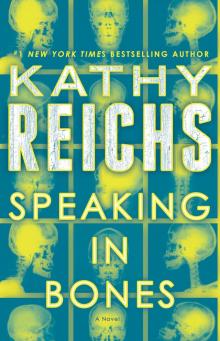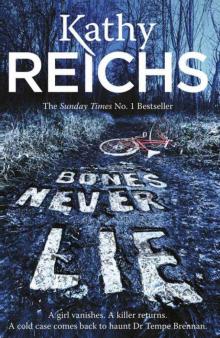- Home
- Kathy Reichs
Speaking in Bones Page 2
Speaking in Bones Read online
Page 2
“Eighteen makes her adult. She can come and go as she likes. Blah. Blah. Blah.”
“That’s true.”
Strike jerked a thumb at the Ziploc. “That sound like someone doing as she likes?”
“You think Cora Teague is the girl on that recording?”
Strike gave a slow nod of her head.
“Why bring this to me?”
“I believe you’ve got parts of Teague stashed here.”
“I should ask a detective to join us.”
“No.” Realizing the sharpness of her tone, Strike added, “Not yet.”
“Okay.” For now. “Tell me about Teague.”
“If you’ll bear with me, I’ll share what I know.”
Strike did that shoulder thing again. Not a shrug, more like a slo-mo twitch. Or an unconscious attempt to readjust her spine.
“Cora was born in ’93, the fourth of five kids. The father, John Teague, owns a combo convenience store–gas station–hardware–bait shop. The mother, Fatima, is a stay-at-home housewife. She sometimes works the cash register at the store.
“The older brother, Owen Lee, and the two older sisters, Marie and Veronica, are married. He sold real estate, badly, until the bottom fell out, then started a dog-training business. The sisters both live out of state. Not sure about Eli. He’s the youngest. Guess he’d be about nineteen. Owen Lee and the parents live within miles of each other up in Avery County.”
The Blue Ridge Mountains. Unbidden, an image of Mama flashed and was gone.
I nodded to indicate I was listening.
“According to a posting on CLUES.net, about three and a half years back Cora mysteriously vanished.”
“CLUES.net?”
“Citizens Looking Under Every Stone. The site permits anyone to post about a missing person. It’s like NamUs, only privately hosted.”
“You found a listing on CLUES for Cora Teague.” I wanted to be sure I was getting this straight.
“Yes.”
“Who posted it?”
“There it gets tricky.” Strike planted an elbow on each thigh and let her hands dangle between her knees. “CLUES allows users complete anonymity.”
“Is that standard for websleuthing sites?”
“No. But the guy who runs CLUES thinks folks will be more likely to come forward with information if they’re not required to identify themselves.”
“So a user doesn’t have to provide a name to post an MP or to participate in a forum discussion.”
“Correct. And those listed as missing don’t have to have gone through official channels.”
“Meaning a police report is not required.” This was sounding flaky.
“You’ve got it. So not every MP has an investigating agency attached. When that’s the case, the site operator acts as a clearinghouse for tips.”
“So any wingnut on the planet can enter any rubbish he or she wants.”
“It’s not quite that loose.” Defensive.
“But you have no idea who listed Teague.”
“Do you want to hear this?”
“Go on.”
“Since Cora Teague was never officially reported as missing, her case got zero media coverage. And no attention on the site. I figured if she had turned up dead somewhere, and she was in some database of unidentified remains, no one was working to match her up. She was all mine.”
“Your challenge.”
“Yep.”
“And you like a challenge.” I was starting to get a really bad vibe.
“Something wrong with that?”
“So what happened?”
“According to the posting, Teague dropped off the radar midsummer of 2011.”
“Her LSA?” I used the acronym for last seen alive.
“Avery County. That’s about as much as anyone knows.”
“Did Teague have an Internet presence?”
“None that I could find. No Facebook, Twitter. No email addresses. No use of Buzznet, Blogster, Foursquare, LinkedIn. No iTunes—”
“Cellphone?”
“No.”
An eighteen-year-old kid with no cellphone? That sounded odd. “You spoke to the family. What do they say?”
“They believe she ran off with her boyfriend.”
“That’s often the case.”
“I talked to a few folks up that way. The picture I got doesn’t track with that theory.”
“How so?”
“Teague was a loner. Not the dating type. And I found not one single solitary person ever heard of or laid eyes on a boyfriend. No BFF. No neighbor. No bus driver. No coach.”
“Just the family.”
“Just them.”
“Who is he?”
“They don’t know. Or don’t say.”
“So she kept the relationship secret. Kids do that.”
“Hard to pull it off in the sticks. And Teague moved in a very small circle. Family. Home. Church.”
“Perhaps she met the boy at school.”
Strike shook her head. “No way, according to those I contacted.”
“Was Teague a good student?”
“Not really. She attended a Catholic school for the lower and middle grades. Managed to graduate from Avery County High. No one there remembers much about her. She was on no sports team, participated in no extracurricular activities. The woman I spoke with, a guidance counselor I think, said she was dropped off and picked up daily by a sibling or parent.”
“Wait. You called the school?”
“Claimed I was helping the family.”
Jesus. This woman was something.
“One odd twist.” Strike continued, oblivious to my disapproval. “Teague’s not pictured in the yearbook.”
“There could be any number of reasons for that. She’d had a bad hair day and hated the shot. She was out sick when photos were taken.”
“Maybe. The guidance counselor said Teague’s record indicates chronic absenteeism.”
“Any history of problems with alcohol or drugs?”
“Nope.”
“Any juvie record?”
“I don’t know. After graduation, she took a job as a nanny. Lasted a few months, then got sent packing.”
“Why?”
“Health issues.”
“What sort of health issues?”
“No one would say.”
“Where did Teague go?”
“Home.”
I waited for Strike to continue. She didn’t.
“Let me get this straight. Cora Teague hasn’t been seen in over three and a half years.”
“That’s right.”
“But an MP report was never filed with the police.”
“Correct.”
“The family believes she left on her own.”
“They do.”
“But you think that’s unlikely.”
“Me and whoever posted her name on CLUES.”
I nodded, acknowledging she had a point.
“You suspect Cora Teague’s voice is on that recording.” Indicating the Ziploc.
“I do.”
“You think she was killed and dumped. And that part of her body was recovered and sent to this lab.”
“I’m suggesting you consider the possibility.”
“What makes you think Teague is at this facility?”
“About a year and a half ago, you made an entry on NamUs detailing a partial torso found in Burke County. Burke is right down the road from Avery. The time line fits. The geography fits. The descriptors fit.” Strike straightened and spread her arms wide. “Call me crazy, but I think it’s worth a look-see.”
A specimen cart rattled by in the hall. A door opened, releasing the whine of an autopsy saw cutting through bone. Closed abruptly, truncating the sound.
In my head I heard the wretched little voice on the tape.
Please don’t kill me.
Please.
Kill me.
As before, I felt a chill crawl up my spine.
<
br /> “How did this come into your possession?” Gesturing at the key chain recorder.
Strike leaned back into her chair.
“As I said, I kept scanning sites listing UIDs, hoping a set of remains might link to Cora Teague. Nothing ever did. Then I got sidetracked by personal matters. Had to let it go for a while.”
Strike paused, perhaps pondering the unnamed matters that had temporarily halted her search.
“Last week, I got back to sleuthing. When I spotted your entry on NamUs it was like harps burst into tune. You know. Like on TV.”
I didn’t. But I nodded.
“Your entry included information on where the torso was found, so I decided what the heck? It’s not a long drive. Why not go up and poke around?”
“You went to Burke County? Seriously?”
“I did. Once I got there, it seemed obvious there was only one place a person in a hurry would off-load a body from that overlook. I walked a pattern downhill from the spot. For hours, turned up nothing but bugs. I was about to quit when I spotted a key chain wedged in the roots of a big old tree. Figured the thing was probably there by happenstance. But, being safe, I brought it home.”
Strike’s mouth squashed up to one side, and she went silent.
“You discovered the recording function and played the audio,” I suggested.
“Yeah.” Tight.
“And then?”
“And then I called you.”
A very long silence stretched between us. I broke it, using carefully chosen words.
“Mrs. Strike, I’m impressed with your enthusiasm. And with your commitment to the goal of returning nameless victims to their families. But—”
“You can’t discuss the specifics of a case.”
“That’s correct.”
“About what I expected.” Strike took a quick breath and set her jaw. Preparing to argue? Or to accept rejection?
“But I promise you,” I said, “I will look into the situation.”
“Yeah.” Strike gave a humorless sniff of a laugh. “Don’t let the door smack your arse on the way out.”
Strike snatched up the Ziploc and pushed to her feet.
I rose. “If you leave the key chain, I will ask someone at the crime lab to evaluate the audio.”
Strike repeated the mirthless snort. She really had it down. “I don’t think so.” Dropping the Ziploc into her pack.
I extended a hand. “I will call you. One way or another.”
Strike nodded. Shook. “I’d appreciate that. And your discretion.”
I must have looked confused.
“Until an ID is confirmed, no sense getting the media in a twist.”
“I never grant interviews.” Unless ordered to do so by those higher up the chain of command. I didn’t say that.
“I apologize. Didn’t need saying. It’s just, I prefer doing what’s best for the family.”
“Of course.”
I walked Strike down the hall and watched her disappear into the lobby, all the while debating if and how to share her tale with my boss, Mecklenburg County’s chief medical examiner. I knew the look Tim Larabee would give me. And the questions he’d ask.
Back at my desk, I rolled Strike’s visit around in my head. Considered possibilities.
Strike was a mental case. A con artist. A shrewd detective lacking a badge.
I started with door number three. Strike was a well-meaning though somewhat overzealous websleuth. She’d found the recorder just as she’d claimed. Problems. How had the police failed to spot the thing when they recovered the torso? How had it survived out in the elements for so long?
Say the girl on the audio actually was Cora Teague. Say Strike was correct, Teague is dead and I have her remains in storage. Had the key chain been hers? Had Teague recorded her thoughts while held in some sort of brutal captivity? Had she been murdered?
I moved to an alternate explanation. Strike fabricated the whole story. Faked the audio. Problem. The scam would be quickly discovered and Strike revealed as a fraud. Why do it? Because she’s nuts? Because she craves media attention? Doors one and two.
Or maybe Teague was the scammer and Strike her gullible victim. Perhaps Teague and two male companions staged the interchange on the recording, and somehow led Strike to the key chain. Teague had been in the wind for three and a half years. Perhaps she wanted to stay there. Problem. The tape sounded eerily real. The anguish in that voice would have the opposite effect on anyone who listened.
Or maybe Teague was working in league with Strike. Same question. Why? What did they hope to accomplish?
In my line of work, I encounter a range of human motivations as broad as the South China Sea. I’m pretty good at spotting deception. At assessing character. Looking back on that encounter, I’m forced to admit, I hadn’t a clue what to think of Hazel “Lucky” Strike.
I stared at the bright yellow file on my blotter. Larabee would be anxious for word on the mummified corpse.
I was still staring when my iPhone beeped an incoming message. The flight reminder triggered an unexpected wave of uneasiness.
Decision.
Deep breath, then I dialed. As my call winged north, I pictured Ryan and chose words to structure my argument.
Andrew Ryan, lieutenant-détective, Service des enquêtes sur les crimes contre la personne, Sûreté du Québec. Translation: Ryan works homicide for the Quebec Provincial Police. I am forensic anthropologist for the Bureau du coroner in La Belle Province. For years we have investigated murders together.
For a period, Ryan and I were also a couple. We both chose to end it. Then he chose to drop off the map. Recently, he’d chosen to return from exile and propose marriage. Months down the road, my mind was still too boggled to deal.
I pictured Ryan’s face. No longer young, but the crags and furrows in all the right places. The sandy hair and electric blue eyes. Eyes that would now show disappointment.
I grinned, despite my apprehension over the upcoming conversation. Ryan had that effect on me. I really did miss him.
Ryan answered, sounding cheerful as a balloon on a string. “Madame. I have reserved a prime table for two at Milos. And organized a full range of postprandial activities. Also for two.”
“Ryan—”
“ ‘Postprandial’ means after supper. Said activities will take place in the privacy of my home.”
“I hate to do this, but I have to cancel.”
Ryan said nothing.
“A case has come up. Two, actually. I’m sorry.”
“Well, there’s some things a man just can’t run away from.” In a bad John Wayne imitation.
“Stagecoach.” I guessed the film. It was a game we played. “Do you want to hear about the cases?”
“Perhaps later. When can you reschedule?”
“As soon as I’ve finished.”
A beat, then, “Tempe, deep down I fear that quote really nails it.”
“What does that mean?”
“Are you sure you’re bailing on this visit because of work obligations?”
“Of course it’s because of work.” Was it? My throat felt tight and my eyes burned. “Talk tonight?”
“Sure.”
The line went dead.
I sat a moment, feeling lonely and confused. Half decided to call Ryan back to say that I’d changed my mind. Instead I dialed US Airways.
As I spoke to the agent, my eyes fell on the yellow folder. On the chair Hazel Strike had occupied.
Again, I imagined the terrified girl on the recording.
I’d bumped Ryan. Recliner Man could also wait.
But before discussing Strike with the boss, I’d check the facts. I remembered little about the case. Only that I’d done the analysis as a special request since the MCME doesn’t normally investigate deaths occurring in Burke County. Couldn’t recall the reason I’d been tagged for this one.
Thanks to Strike, I knew the remains had turned up approximately eighteen months earlier. And t
hat I’d entered them into the NamUs database.
Logging on to my computer, I used the key words “Burke County” and a limiter for dates. It took just moments. The decedent had been registered at our facility as ME229-13. I pulled my report and scanned the contents.
ME229-13 arrived on August 25, 2013. The remains had been found by a hunter. By his dog, Mort, to be fair. I remembered chuckling at the irony of the name. Inappropriate, but I had.
Mort had made his macabre discovery twenty miles north of Morganton, off NC Highway 181. The bones lay downslope from an overlook, scattered over fifty square meters and covered in leaves and debris. Apparently, old Mort possessed one hell of a nose.
The investigating officer was a Burke County sheriff’s deputy named Opal Ferris. It was coming back now. I recalled my surprise that Ferris had been canny enough to spot something suggesting the remains were human. That she’d bothered to walk the site to collect more. That she’d delivered Mort’s booty to the local ME.
I read the section of my report titled “Postmortem Condition.”
Little soft tissue had remained, the work of scavengers and nature’s inevitable march. The small amount present consisted of leathery bits of ligament, enough to keep two segments of spinal column articulated. The rest had survived as isolated elements. My skeletal inventory listed eighteen partial ribs, fifteen complete and three fragmentary vertebrae, two partial clavicles, fragments of right and left scapula blades, and one fragment of sternum.
In the section titled “Age at Death” I’d entered a range of seventeen to twenty-four years. My estimate was based on the youthful appearance of the three sternal rib extremities, the ends where the ribs attach via cartilage to the breastbone. And on recent fusion of the growth cap on the medial end of the right clavicle. The left clavicle had been too damaged for observation.
Using measurements taken from the hunks of intact spine, I’d calculated height as somewhere between sixty and seventy-two inches, a range so broad it was virtually useless.
Based on bone quality, and on the presence and amount of desiccated soft tissue, I’d estimated PMI, postmortem interval, at a minimum of three months to a maximum of two years.
I’d been unable to determine gender or ancestry.
That was it.
I left the MCME system, went to the Internet, and typed in www.NamUs.gov. After entering my credentials, I chose the Unidentified Persons Database, and provided the number assigned to the Burke County torso. The section marked “Case Information” included the date and location of the find, and the date of the file’s creation. No modifications had been made since the time of the latter. The individual’s status remained “unidentified.” I was listed as both the local contact and the case manager. Fair enough. That’s how Strike had found me.

 Two Nights
Two Nights The Bone Collection: Four Novellas
The Bone Collection: Four Novellas Fatal Voyage
Fatal Voyage 206 Bones
206 Bones Bones to Ashes
Bones to Ashes Terminal
Terminal Monday Mourning
Monday Mourning Flash and Bones
Flash and Bones Cross Bones
Cross Bones Devil Bones
Devil Bones Break No Bones
Break No Bones Swamp Bones
Swamp Bones Déjà Dead
Déjà Dead Shock
Shock Spider Bones
Spider Bones Death Du Jour
Death Du Jour Grave Secrets
Grave Secrets Trace Evidence: A Virals Short Story Collection
Trace Evidence: A Virals Short Story Collection Bones on Ice
Bones on Ice The Bone Code
The Bone Code Bones in Her Pocket
Bones in Her Pocket Seizure:
Seizure: Speaking in Bones
Speaking in Bones Deadly Decisions
Deadly Decisions Spike
Spike Bones Never Lie
Bones Never Lie Bones of the Lost
Bones of the Lost Virals 03.5 - Swipe
Virals 03.5 - Swipe Exposure
Exposure A Conspiracy of Bones
A Conspiracy of Bones Shift (tory brennan)
Shift (tory brennan) Bones of the Lost: A Temperance Brennan Novel tb-16
Bones of the Lost: A Temperance Brennan Novel tb-16 Virals tb-1
Virals tb-1 Bones Are Forever tb-15
Bones Are Forever tb-15 Code tb-3
Code tb-3 Seizure tb-2
Seizure tb-2 Deadly Descisions
Deadly Descisions Spider Bones: A Novel
Spider Bones: A Novel